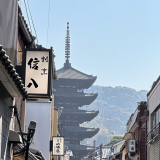How I Managed Severe Allergies While Studying Abroad in Madrid
January 27, 2025
Introduction:
My semester in Madrid was incredibly impactful, and my experiences will stay with me for the rest of my life. I want to share my story as a person with multiple severe food allergies to provide comfort to anyone who may be worried about how to eat and survive while studying in Spain. Food allergies make eating out anywhere tricky. Add a foreign country, unique food, and a different language, and it can feel impossible. Learning about the cuisine and expanding my Spanish vocabulary helped me advocate for myself and taught me how to successfully navigate the Madrid food scene. (photo #2)
Allergies in Madrid:
I got to discover and experience Spanish food classics such as Paella and Patatas Bravas. Nuts are an uncommon ingredient in Spanish food, so I easily avoided my anaphylactic allergens. (photo #4)
Many restaurants had an allergen key on their menu like this:

The icons appeared next to the menu items that contained them, a visual representation of off-limits menu items. However, I had to remain cautious because some ingredients, like butter or mayonnaise, slipped under the radar, even when no allergen icon was next to a dish.
Some restaurants didn’t have these icons. In those cases, I would rely on my knowledge of typical ingredients or ask for a menu with allergen information.
Eggs, dairy, and gluten proved most difficult to avoid. Some of their most iconic dishes, such as Tortilla de Patatas, are made with these. Some traditional tapas restaurants didn’t give a choice of what tapa you receive. When you order a drink, they add a mystery tapa. I talked to someone working the bar. After telling them my allergies, they only served tapas I could eat. (photo #5)
How to ask for accommodations:
I would love to teach a class on communicating about dietary restrictions and advocating for yourself in Spanish, but a brief crash course will have to do.
I would lead by saying, “I have a lot of allergies” or “tengo muchas alergias” and asking questions about the menu: “puedo preguntarte sobre algunas cosas en la carta?” or something similar. If you have little or no basis in the language, do not stress; jumping into the next step is okay.
Sometimes, it is best to be as specific as possible. Ask about one or two menu items and whether they contain the allergens you are worried about. For example, when asking about patatas bravas, I would be most concerned about mayonnaise in the “brava” sauce. I would ask, “En las patatas bravas, la salsa contiene huevos o mayonesa?” Or, while pointing to the item on the menu, simply, “contiene huevos?” And, don’t be afraid to ask about all of your allergens using “contiene … ?”
When I was overwhelmed or unsuccessful in finding something to eat, I would tell my server all my allergies and ask what they recommend: “qué recomiendas?” They would recommend something stellar, or start a helpful back-and-forth conversation.
To ask for a menu with allergen information, I would ask: “Tienes una carta con información sobre alérgenos?”
The safest option: Grocery stores and cooking for yourself:
Thanks to CEA CAPA, there will be a grocery store within a 5-minute walk of your apartment. I was in a fantastic spot with at least 5 stores within a few blocks, including one called El Corte Ingles. It was slightly more expensive than other stores, but had the biggest allergy-friendly selection. It was invaluable when I needed quick snacks for long school days or traveling. (photo #3)
Some special places:
Madrid is a massive city, and you will find places that suit your needs. My favorite was Chocolatería 1902, which sold gluten-free, vegan Churros con Chocolate, an iconic Madrid food. (photo #1)
Outside of Spanish Cuisine, Madrid boasts a variety of international restaurants. I could safely eat familiar cuisines, find affordable meals, or try new cuisines. My favorites were Kebab, Sushi, Tierra, and Tiki Taco.
The European gluten myth:
People with celiac may have heard that gluten in Europe is safer for us than in the US. I have heard it is related to some differences in how wheat is processed. I wanted it to be true, so I tried some bread. But, it didn’t work out. (photo #6)
When things go wrong and how to deal with it:
My second week in Madrid, I got Indian food with a new friend. I ordered a delicious dish, my usual in the US. On my way home, I started feeling symptoms. Since my food was impressively spicy, I didn’t think that the swelling in my throat or the hot redness in my face was anaphylaxis.
When I arrived home, my symptoms worsened. I got hives. I immediately took Benadryl and waited for my symptoms to improve. It was a slow reaction (I apparently ingested trace amounts of allergen), so I luckily had time to decide a course of action. When my symptoms didn’t improve, I went to the hospital.
CEA CAPA recommends Hospital de Madrid because they have the most straightforward payment system with insurance. I didn’t go there; I just went to the closest one. The employees didn’t speak much English, which was okay for me, but if you need to communicate in English, I recommend you go to Hospital de Madrid.
I was given an IV with antihistamine and a steroid to stop and reverse the reaction. I stayed in the hospital until my symptoms subsided, then was on my way. The next day, I picked up my prescription of oral antihistamine and prednisone, (in case the reaction relapsed) at the closest farmacia.
Pharmacists in Madrid make helpful recommendations after listening to your symptoms. Benadryl doesn’t exist in Spain, so ask for a strong antihistamine, tell them what it’s for, and they will give you what you need.
The bill was less than I would have paid as a copay in the US. However, finding a way to pay was challenging. After many dead ends, I paid easily with Wise, an app for transferring money without borders.
Very important: keep ALL receipts, bills, and other papers to send a complete claim to insurance. Amazingly, a full refund was mailed to my US address.
Concluding advice for fellow students with allergies:
Take a deep breath… The most important thing is to advocate for yourself. I understand it can be daunting, especially in an uncomfortable environment with a new language. Be patient with yourself and with anyone you ask for help. You will gain valuable skills and have a great time studying abroad! (photo #7)
Photos:
#1: Gluten and dairy free churros con chocolate at Chocolatería 1902

#2: A rooftop dinner in Gran Vía with my roommate

#3: One of my favorite meals I cooked for myself while living in spain: coconut curry with rice and baby greens!

#4: The best Paella ever at a small local restaurant in Valencia

#5: Massive tapa servings of chorizo, olives, chips, and jamón iberico

#6: A tiny bite of bread

#7: My roommate treated me to delicious Peruvian food on my last day in Madrid!

Kara Tangenberg – Electrical Engineering – Spring 2024 – Madrid, Spain – CEA CAPA at Universidad Carlos III De Madrid

